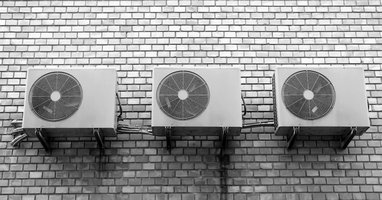Different Types of Garage Heaters (How They Work & Safety)
This post contains affiliate links.
One of the best ways to ensure you can use your garage year-round is to insulate and install a heater and a cooler. This allows you to cool the garage down during summer and warm it up during winter.
However, deciding the right type of heater for your garage can be hard. There are so many types, and you may also need to know how they work. What are the different types of garage heaters?
The major garage heater types include:
- Forced Air Garage Heaters
- Convection Garage Heaters
- Radiant Garage Heaters
- Portable Garage Heaters
- Mounted Garage Heaters
- Blue Flame Heaters
- Oil Filled Heaters
This post explores the types of garage heaters and the fuel used to power them. We also examine some common questions when shopping for a heater and safety tips.
QUICK TIP: Looking for a buyer’s guide instead? Check out our review on the best garage heaters for your garage.
Types Of Garage Heaters
Garage heaters can be separated into many types. These can differ in fuel, operation, mounting, and portability. However, here are some of the major garage heater types you commonly see:
Forced Air Garage Heaters
Forced air garage heaters work by blasting hot air in cycles into your garage. This heater type may be powered by different fuel types. These include natural gas, kerosene, and propane. It is a very cost-effective system to operate. This is because gas is often cheaper than electricity.
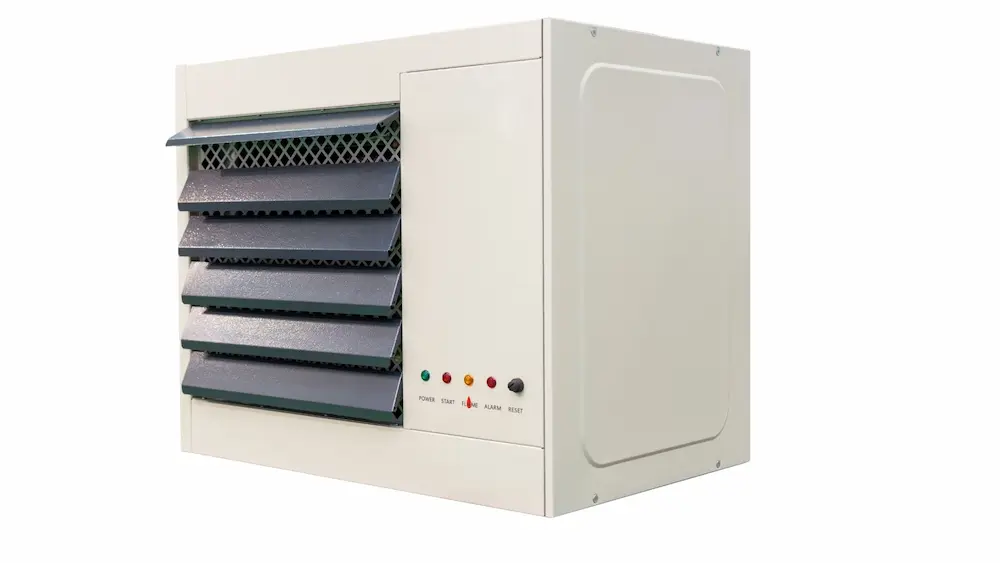
One issue to remember is that a forced air heater will stir up any particles in your garage. This can be a big problem if you work with wood, paint, or coat things. With a forced-air heater, the air is warmer at the ceiling and cooler at your feet.
Convection Garage Heaters
Convection garage heaters work like an oven or a toaster. When turned on, electricity runs through the heater. It then warms up the heating element inside the radiator.
The heat then dissipates into the air, slowly warming the place up. Some convection garage heaters come with a fan to blow the hot air. Convection garage heaters are usually fueled by oil or electricity.
Convection garage heaters are also one of the most affordable heaters you can get. However, they do take a long time to heat up a space. You can get them in portable or mounted form.
Radiant Garage Heaters
Radiant garage heaters warm the object, but not the air in between. This is usually achieved by using Infrared (IR). Infrared heaters usually work together with infrared reflectors to direct heat outward.
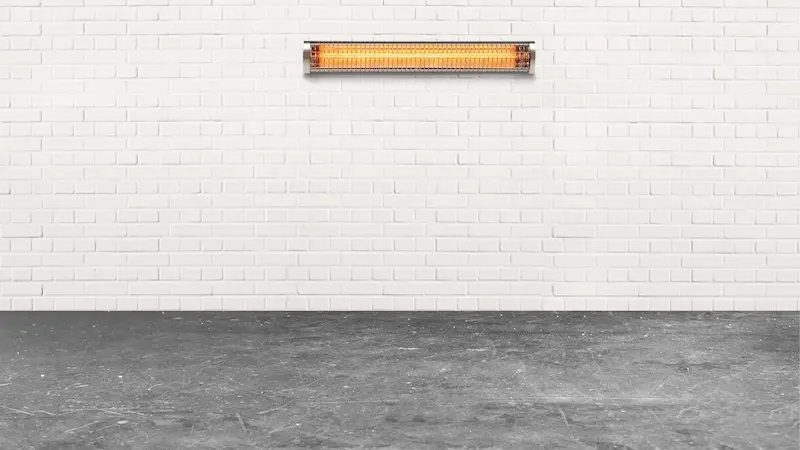
If you install several large overhead units, this should be able to heat the entire garage. Radiant heating systems can also be installed under a floor. Underfloor installation works great with epoxy floors.
Radiant garage heaters offer steady warmth in still air. This means it does not blow air to stir up dust or keep dust airborne. This may be important if you work on woodwork or painting work. They are also available in a range of sizes.
Radiant heaters can come in many configurations. They can be mounted or portable. They could also use natural gas, propane, or electricity. Infrared heaters are quiet, but placement in the garage can be critical.
When shopping, avoid high-intensity infrared heaters that glow visibly red. Most of them aren’t approved for residential usage.
Portable Garage Heaters
Portable garage heaters can be forced air, convection, or radiant. But they are usually smaller and can be easily moved around. They are also very popular as they are affordable.
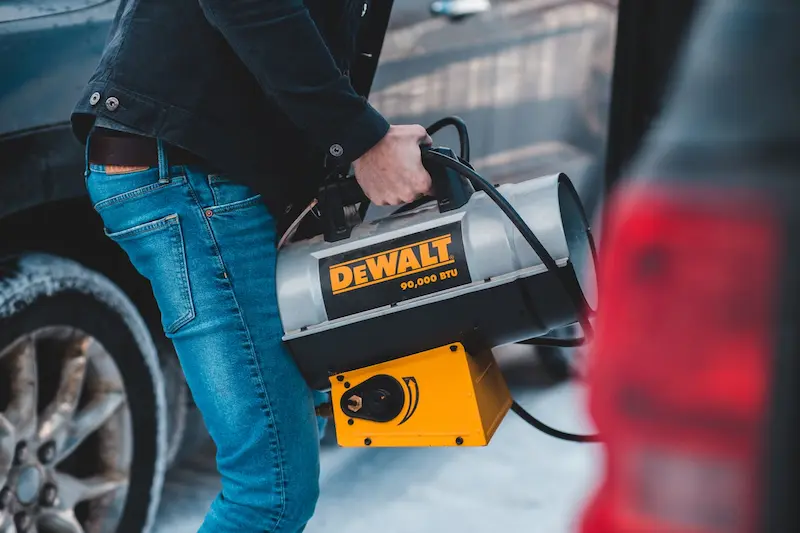
For fuel, propane is most common, followed by electricity and kerosene. Gas models produce a lot of heat for their size. If you want fast heating, use portable heaters with forced air.
With portable heaters, you can move the heaters with you around. The downside is that they can be trip/tip-over hazards since you may leave wiring on the floor.
One thing to be careful about is the fans. The fans can stir up all dust and other particles in your garage. Some models produce fumes of water vapor. This means you need ventilation in your garage.
Mounted Garage Heaters
Mounted garage heaters are the opposite of portable heaters. They are mounted to the wall or ceiling. With mounted garage heaters, you have a much wider variety of options. These include operation, fuel type, size, and price.
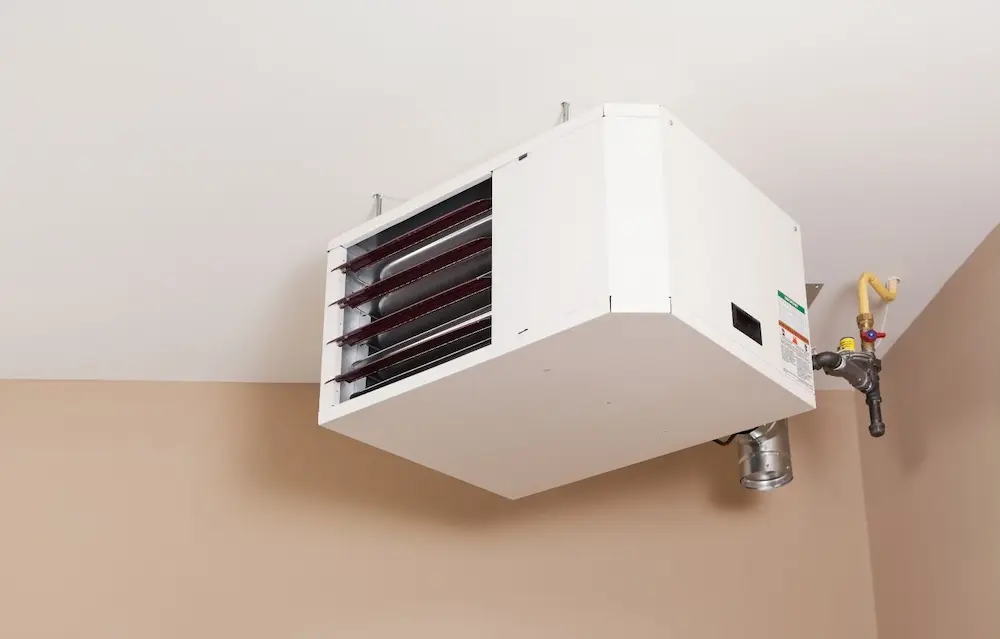
Almost all mounted heater units come with adjustable thermostats. They also have built-in safety features and remote control. However, they usually cost more than portable types. However, you get what you pay for since they are much more powerful.
One best thing about mounted heaters are that they free up floor space. You don’t need to worry about cords or tripping over a heater.
On top of that, some fan-forced mounted heaters come with adjustable louvers. This allows you to direct the heat where you want it to go.
Blue Flame Heaters
Blue flame heaters use natural gas or propane as fuel. They are called blue flame heaters because of the blue-colored flame they produce.
Blue flame heaters can be portable or mounted. They can also operate using forced air, convection, or radiant. They also come in many sizes and can be used for home, commercial or industrial settings.
The best thing about blue flame heaters is their efficiency. The blue flame indicates complete burning. This means no smoke or carbon will pollute your garage. Fuel such as natural gas is also cheap, making them affordable to many.
Oil Filled Heaters
Oil-filled heaters are heaters that use a reservoir of thermally conductive oil. These oils are kerosene, regular heating oil (No. 2), or Bioheat oil. Ultra-Low Sulfur Heating Oil (ULSHO) is also popular today.
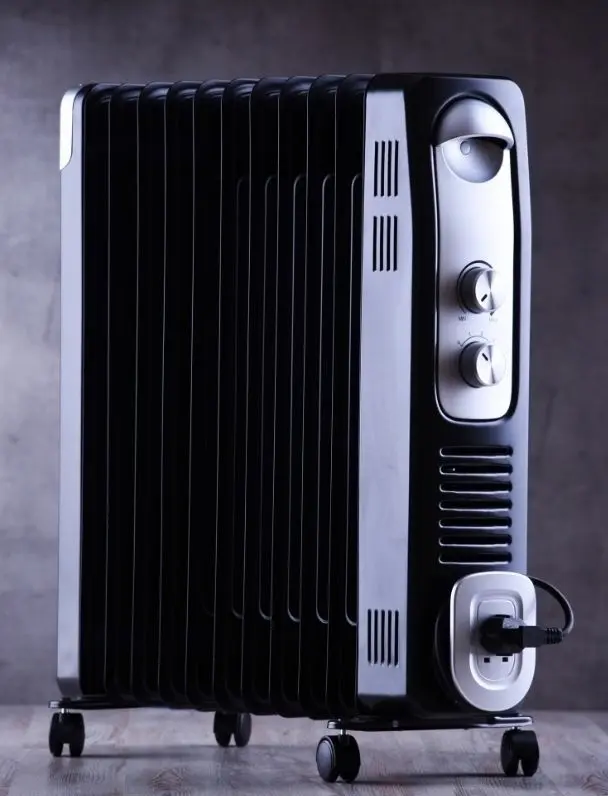
The oil is heated by an electric heating element inside the heater. The oil warms up and retains the heat even if the heater is turned off.
The warm oil then circulates throughout the heater. This sends its heat to the metal fins or coils on the radiator of the heater. The heat then escapes, warming up the surrounding area.
Oil-filled heaters provide slow, steady, and even heat to their surroundings. They are also known for their quiet operation. Oil-filled heaters are also safer. This is because they do not have exposed heating elements. As a result, they are less likely to cause fires or burn hazards.
Types Of Power/Fuel For Garage Heaters
Popular fuels used to power garage heaters include electricity and natural gas. There are also propane and kerosene. Each heating fuel comes with its own upsides and downsides.
| Fuel/Power | Pros | Cons |
| Electricity | -No open flames. -No fumes. | -Needs electricity supply. -Cost. -Can dry out air. |
| Natural Gas | -Clean burning. -Cheap. | -Needs piping. -Less mobile. -Safety concerns. |
| Propane | -Portability. -Independent fuel source. -Clean. | -Requires proper storage and handling. -Carbon monoxide risk. -Limited runtime. |
| Kerosene | -Cheap. -Clean burning. | -Odor. -Requires proper storage and handling. |
Electricity
Electrical heaters don’t use open flames and don’t create waste fumes. Hence, they’re safe to use in small spaces. Electric heaters are also compact, reliable, and lightweight.
One issue with electric heaters can be cost. This is because electricity can be expensive, especially during winter. On top of that, electric heaters pull a lot of power. You must set up a designated electrical circuit and breaker to handle the heater.
Electric heaters can also dry out air due to the way it works. If dry air is causing issues for you, consider running a humidifier alongside. Electric heaters can help you spaces are large as 600 square feet (about 56 square meters)
Natural Gas
Natural gas is an excellent way to fuel your garage heaters. Although it produces flames, it is very efficient and clean. The flames are blue, and there’s very little carbon or fumes. Natural gas is also cheap compared to electricity.
But, natural gas heaters will need piping to run gas up to the heater, which means extra work and cost. Natural gas pipes can also leak, making your garage a fire hazard.
Natural gas heaters can heat up space as large as 4,500 square feet (about 418 square meters)
Propane
Propane is also a form of gas, familiar to those that enjoy a barbeque. But, unlike natural gas, you usually buy propane in independent tanks. You do not need a pipeline to set up a propane heater.
Propane heaters also produce an open flame. But, the burning is also very efficient and clean.
The issue with propane is that you must figure out a way to properly store your gas tanks. Your heater also cannot work continuously. This is because the heater will stop when the propane inside the tank runs out.
Propane heaters are also quite efficient. They can heat up space as large as 4,500 square feet (about 418 square meters)
Kerosene
Kerosene can be similar to propane, although they do not burn as clean. Kerosene is also a little more expensive than propane or natural gas. However, kerosene can be cheaper than electricity. This is especially true if you buy them in the summer and stock them in the winter.
Filling a kerosene heater can be messy and potentially dangerous. This means you need to have a way to store and handle them. Kerosene can also have a particular odor, so ventilation may be required.
Which Heater Is The Best For Garages?
The best heater for your garage may depend on several factors. These include fuel availability, cost, heating speed, and mobility. The type of work you perform inside your garage also plays a factor. The key is to select the best balance between these factors.
Selecting the best heater for your garage can be an issue. This is because there are too many types to choose from.
However, one way to start picking the right heater for your garage is to start with what you have and need. We listed several factors below you can think about, to narrow down the range of heaters you can use.
Cost
The cost will be a huge factor in your heater selection. Cost can be further broken down into the set-up cost and the long-term usage cost.
Set-up cost points to the spending you need to purchase and install the heaters. If you use professional help to install your heaters, they will cost more too.
Some heaters, such as mounted gas heaters, will cost more to set up. This is because you need to run gas lines.
Long-term usage cost will point to the cost to keep your heaters running long-term. This includes fuel and maintenance. If cost is not an issue, you can get away with any fuel you fancy. However, you may want to think about propane or kerosene for lower-cost operations.
You can buy these fuels during the summer and stock them for winter. Prices may increase during winter since there is a spike in demand. You cannot do the same with natural gas or electricity.
Fuel Availability
Your choice of garage heater may also depend on the type of fuel available in your area. If your area does not have a certain fuel type, it makes no sense to use the heater type. The key is choosing the heater where you can easily access the fuel or energy.
For example, not all houses and garages have access to gas pipelines. In this case, you may not be able to use gas heaters. Electric heaters may also not make sense if your garage is in an area with electricity access issues.
Your Work Inside The Garage
Your choice of garage heater may also depend on the work you do inside your garage. This is because garage heaters work differently and can interfere with your work.
For example, if you do a lot of woodworking inside. This means you will have wood chips or sawdust inside your garage. In this case, heaters with open flames will be very dangerous since the flame can burn the dust and start a fire.
Similarly, if you do a lot of painting or artwork. You may prefer a still air to prevent messing with your work. In this case, forced air heaters will not work well.
Speed
Not all heaters work at the same speed. Some can warm up your garage fast, while some take time.
If speed is your concern, electric or fuel-based heaters with fans may do well. This is because the forced air helps to move the heat around and warm up the air faster.
If you do not mind slowly warming up, oil-filled heaters may be better. They are also likely to be energy efficient too.
Mobility
Mobility is also another major issue. If you prefer to move your heater around, then getting a portable one makes sense. Better still, get those that do not need a wired connection to prevent tripping hazards.
If you prefer to have your heater at the same location, set up a mounted one instead. They are usually larger and can provide better heating.
Moving Or Still Air
Depending on your style, you may prefer having moving or still warm air inside your garage. If you like moving air, heaters with fans will be a good idea. The warm air also travels around the garage, warming it up faster.
You can opt for other heater types if you prefer still air. Blue flame or electric heaters with no fans usually will be fine for you in this case.
Safety
Some garage heaters come with safety features you may find useful. If you prefer them, you can pick up garage heaters with them. Some of these safety features include:
Tip-over switch: This switch automatically turns the heater off when tipped over. It also stops the heater if there is an operational failure.
Thermostat: A thermostat switches the heater off if oxygen is below a certain level.
High Heat Automatic Shutoff: Automatic shutoff in case of high temperatures.
Cool-touch Body: Some heaters have heat shields. If you accidentally touch the heater, your hands will not burn.
What Size Of Heater Do I Need For My Garage?
You can determine the right heater size by looking at the heater’s British Thermal Unit (BTU) rating. A regular 2-car garage needs a heater with about 45,000 BTU. For a 3-car garage, look for heaters with 60,000 BTU. Infrared heaters need less BTU rating.
Determining the best heater size for your garage depends on many factors. These include things such as garage size. There are also issues, such as the climate zone where you live.
You must also consider your preferred temperature and whether your garage is insulated.
When calculating the size of the heater you need, you first should know the following:
- The square footage of your garage
- The height of your ceiling
- The insulation level, and
- How much temperature do you want to raise.
Another way is to look at the BTU rating of the heater. The higher the BTU rating, the more heat it can generate. This means it can warm up a larger space.
Here are some basic recommendations for forced-air heaters. You need 45,000 BTUs to heat a 2 to 2-1/2 car garage. Get a 60,000 BTUs heater for a three-car garage.
Low-intensity infrared heaters may need 30,000 BTUs to warm up a 2 to 2-1/2 car garage. Make it 50,000 BTUs for a three-car garage.
Safety Tips When Using Garage Heaters
Some common safety tips when using garage heaters include:
- Always be alert if you smell leaks
- Never leave the heater unattended.
- Avoid moving the heater while it’s on.
- Clean the heater regularly.
- Keep away from flammable materials.
As much as heaters are a godsend, especially on cold days, they can easily be dangerous. Not used carefully, garage heaters can cause fire and accidents that can take lives.
Here are some safety tips you can practice whenever you use garage heaters:
Be Alert Of Leaks: If you suspect a leak, take action. Switch off the gas line at the source. Don’t use lighters or anything else that can produce a spark.
Don’t Light Up When You Smell Something: If you smell gas, oil, or other fumes in your garage, don’t start the heater. You may cause an explosion.
Keep Clear From High-Traffic Areas: Don’t place portable heaters in high-traffic areas. Keep them away from animals and children.
Keep Away From Flammable Materials: Don’t place the heater near flammable items.
Don’t Use Extension Cords: They are prone to getting hot and causing shorts. The risk is higher since heaters consume a lot of electricity.
Clean Regularly: Clean the heater to prevent dust and debris from building up. They can catch fire.
Use Indoor Heaters: Purchase a heater that is suited for indoor purposes.
Turn On Only When Using: Switch off the heater as soon as you’re done using it, and never leave your heater unattended.
Turn Off The Heater Before Moving: If you want to move your heater, switch it off and wait for it to cool down first. Then move it. This lets the fuel or components settle down first to prevent untoward issues.
FAQ
What Temperature Should You Keep in a Heated Garage?
You may like your garage to be warm enough you do not need to wear sweatshirts to work in. However, that will require your heater to work hard and crank up your electricity bill.
Consider a cool temperature of 45-60°F or 8-15°C. It may not be toasty warm, but at least you get to save a lot of energy. The temperature is also capable of keeping your stuff and car from freezing.
If you need to use the garage for a DIY project or work, Raise the temperature to 70°F or 20°C.
This temperature should be good enough for you to spend longer in your garage.
On top of the temperature, aim for a humidity of around 45-50%. If it’s higher, you may need to ventilate your garage better.
You can also use a dehumidifier. You can also shut off the heating system and open the garage door about 10 inches or 30 cm for 15 minutes.
How many BTUs Does It Take To Heat Up My Garage?
British Thermal Units (BTUs) are how heat output is measured. A BTU is the energy required to warm a pound of water by 1°F. One unit of BTU is around 1055 joules.
If you operate in wattages, one watt is about three and a half BTUs.
The general idea here is that the higher the BTU ratings, the larger the area the heater can warm up. A heater producing 1,000 BTU will heat 1,000 lbs of water by one degree Fahrenheit per hour.
One good thing about BTUs is that you do not need to do the calculations. Usually, manufacturers tell you the largest area in square feet that the heater can heat. You can see the numbers on the heater’s packaging itself.
The number these manufacturers give is based on garages with 8-foot ceilings. You may need to discount your ceiling in your calculations if your ceiling is higher.
If you insist on performing your own calculations, you can use the formula below:
First Method
Insulation * Cubic Feet of Garage * Temperature Rise) / 1.6 = # of BTU
You can use these numbers to represent the insulation:
- Heavy insulation 0.5
- Medium insulation 1.5
- Light insulation 2.5
- No insulation 3.5
Here is a calculation example for you:
Area = 3,840 cubic feet
Temperature rise targeted = 35°F
Insulation = average
(1 * 3840 * 35) / 1.6 = 84,000 BTU
If you want to get this down into watts, divide the BTUs by 3.41. This means 84,000 BTU is about 24,633 watts.
Second Method
1. Take the cubic feet of your garage (length x width x height). (For example, 25x25x12 = 7,500 cubic feet)
2. Look at the outside temperature. Assume the coldest temperature. Also, decide on your ideal room temperature (Let’s assume 30°F outdoor and 70°F indoor)
3. Subtract the cold temperature from your targeted temperature (70°F-30°F = 40°F)
4. Multiply that by your cubic feet (40 x 7,500 = 300,000)
5. Then Multiply by 0.133 (or 0.2394 if you used Celsius) (300,000 x 0.133 = 40,000 BTU for a 25′ x 25′ garage with a 12-inch high ceiling)
You can use this rule of thumb to help you calculate too:
1 sq ft = 10 W = 34.1 BTU
We used the rule of thumb and calculated the suitable garage heater rating for common garage sizes:
| Garage Size | Power in Watts | Power in BTUs |
|---|---|---|
| 240 sq ft (12×20 1 car garage) | 2,400 W | 8,200 BTU |
| 440 sq ft (22×20 2 car garage) | 4,400 W | 15,000 BTU |
| 620 sq ft (31×20 3 car garage) | 6,200 W | 21,200 BTU |
| 800 sq ft (40×20 4 car garage) | 8,000 W | 27,300 BTU |
| 1000 sq ft | 10,000 W | 34,100 BTU |
| 1500 sq ft | 15,000 W | 51,200 BTU |
Obviously, this is a very rough estimate. For more accurate numbers, you must consider climate, ceiling height, and insulation.
Which Is Better: Blue Flame Or Infrared (IR) Heaters?
They are just as good. The difference is in operation, which means one of the heating systems may suit your needs better.
Both blue flame and infrared heaters are extremely efficient (usually 99%). Using about the same amount of gas produces the same amount of overall heat.
Blue flame heaters operate by warming the air in the room. Infrared heaters use gas or electricity to heat panels that beam out IR energy. The energy is then absorbed by the objects with which they come in contact. They then get warm.
If you prefer something more conventional, consider using a blue flame heater. If you prefer to heat objects rather than the air, IR heaters work well too.
Which Is Better: Gas Or Electric Heaters?
Both have their upsides and downsides. The key is to see which one suits your needs better. If cost matters to you, consider gas heaters. They may be less efficient than electric heaters, but natural gas or propane are cheaper.
Electric heaters are cheaper, but you may pay higher electricity bills later. Electric heaters do not produce open flames or leak gas or fumes. In this case, it may be safer to use electric heaters.
Aside from those, you can buy fuel for gas heaters during summer when they are cheaper. You cannot do the same with electricity and may need to pay more for heating in winter.
Do Garage Heaters Use A Lot Of Electricity?
The cost of an electric heater depends on the per kilowatt cost in your region. If your heater has a 1000-watt rating and your electricity cost is $0.15/Kwh, your need $0.15 to run your heater for an hour. Check your electricity bill to see the rate per kilowatt-hour.
You can determine power usage by checking the power requirements of your current heater or a new one. It’s on the specification label. Power usage is measured in kilowatts—the equivalent of one kilowatt-hour.
Take the kilowatt number, multiply the hours of use by the heater size, and you get your daily energy cost.
Multiply by the estimated number of yearly usage days. You now have your estimated annual power costs.
You can use the table below to roughly judge the required wattage to warm up your room:
| Room Sq. Ft. | Heater Wattage |
|---|---|
| 50 | 500 |
| 100 | 750 |
| 125 | 1000 |
| 150 | 1250 |
| 175 | 1500 |
| 200 | 1600 |
| 250 | 2000 |
| 300 | 2500 |
| 350-400 | 3000 |
| 450-500 | 4000 |
- Determine Square feet by multiplying room width by room length.
- Look at recommended watts from the chart.
- Lots of windows? Exact square footage not listed? Choose the next highest wattage.
- Warmer climate? Newer home? Choose the next lowest wattage.
This is a very rough estimate. For a better estimate, you must consider climate, ceiling height, and insulation.
For every million BTUs of heat output:
- A gas heater will cost you $18
- A propane heater is around $30
- An electrical heater will cost about $35.
These prices can change due to seasonal changes in fuel and energy costs.
Can You Heat An Uninsulated Garage?
You can. But it will blow a hole in your heating bill. This is because the warm air may easily escape from the garage. This means your heater needs to work extra hard to warm you up.
Consider insulating your garage walls, doors, and ceiling. The insulation will pay for itself in 2-6 years through lower energy costs.
When the ceiling, walls, and door are insulated, garage heater efficiency goes up 100% or more. Insulation helps you save money long-term.
However, if you cannot insulate your garage, use infrared heaters. They are ideal for uninsulated and drafty spaces. This is because they heat objects and not air.
Suppose you can ventilate your garage properly. In that case, a portable propane heater is a good choice for an uninsulated garage.
How Much Does It Cost To Heat A Garage?
The actual cost to heat a garage may depend on your fuel choice, heater rating, and how frequently you use it.
The average price for an electric garage heater ranges from around $100 to $400. Their energy use can boost your monthly electric bill by about $20 to $100. The average installation price can range from about $500 to $2,000.
A natural gas garage heater usually costs about $400 to $800. Many heaters come with ventilation equipment, but some companies sell them separately. If that’s the case for your unit, expect to pay about $150 to $300 extra.
If you hire a plumbing professional or an HVAC expert. The average installation price can range from about $500 to $2,000.
A propane gas garage heater usually costs around $150 to $450. Still, you might need to pay more if ventilation equipment is sold separately.
For operating costs, here is the figure. For every million BTUs of heat output:
- A gas heater will cost you $18
- A propane heater is around $30
- An electrical heater will cost about $35.



